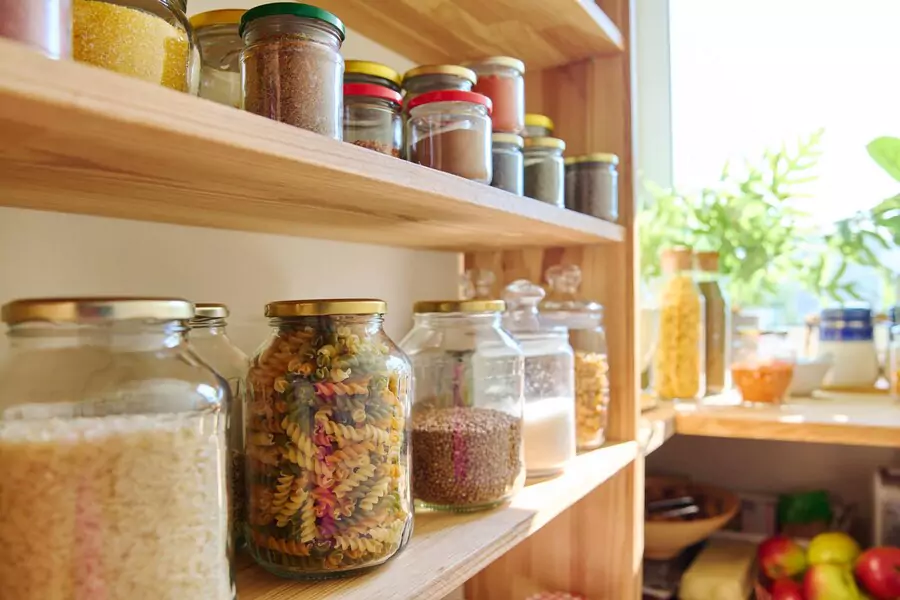If you’re looking to upgrade your recently renovated kitchen or wrangle the chaos of mismatched containers, stop worrying. Whether it’s Plastic, Glass, Metal, or Stackable containers, you’re not alone in struggling to find the best pantry solutions for your needs. When it comes to kitchen organization, many people face the same challenges.
Pantry organization is more than just keeping your shelves tidy—it’s about efficiency, convenience, and peace of mind. But with so many options on the market, it’s easy to feel overwhelmed and unsure of where to start. That’s where we come in.
At Wow Home Shop, we understand the confusion and frustration that comes with choosing the right pantry containers. That’s why we’ve put together this comprehensive guide to help you navigate the options and find the perfect fit for your needs.
When it comes to pantry containers, there are four main materials to consider: plastic, glass, metal, and stackable baskets. Each has its pros and cons, and making the wrong choice can lead to concerns like durability, cleanliness, and even health risks.
But fear not! Our blog is here to break down the differences between each type of container and help you make an informed decision. So whether you’re storing dry goods, snacks, or spices, we’ve got you covered. Say goodbye to pantry chaos and hello to organization bliss with Wow Home Shop!
Different Types of Pantry Storage Containers
Having an organized pantry not only makes cooking and meal planning easier but also helps to reduce food waste. Pantry storage containers come in various materials and styles, each offering benefits and drawbacks. Let’s explore some of the most common options.
Plastic Containers
Plastic containers are perhaps the most popular choice for pantry storage. They are lightweight, durable, and come in various shapes and sizes. One of the main advantages of plastic containers is their affordability. They are also transparent, allowing you to see the contents inside easily.
Advantages of Plastic Containers
Disadvantages of Plastic Containers
Best Uses for Plastic Containers
- Storing dry goods like rice, pasta, and cereal
- Organizing snacks and baking supplies
- Freezing leftovers and pre-prepared meals
Read More
Glass Jars
Glass jars offer a more aesthetic appeal compared to plastic containers. They are non-toxic, non-porous, and do not absorb odours or flavours. Glass jars are also dishwasher safe, making them easy to clean and maintain.
Advantages of Glass Jars
Disadvantages of Glass Jars
Best Uses for Glass Jars
- Storing spices, herbs, and dry ingredients
- Preserving jams, pickles, and sauces
- Displaying homemade snacks and treats
Metal Tins
Metal tins, often made from aluminium or stainless steel, offer durability and versatility. They come in various shapes and sizes, making them suitable for storing a wide range of pantry items. Metal tins are also lightweight and resistant to rust and corrosion.
Advantages of Metal Tins
Disadvantages of Metal Tins
Best Uses for Metal Tins
- Storing tea bags, coffee beans, and loose-leaf tea
- Keeping cookies, crackers, and other baked goods fresh
- Organizing small items like spices, nuts, and seeds
Baskets and Bins
Baskets and bins offer a more flexible storage solution for pantry items. They come in various materials such as wicker, fabric, and wire mesh, allowing you to choose the style that best suits your pantry decor. Baskets and bins are also great for organizing items that may not fit neatly into containers.
Advantages of Baskets and Bins
Disadvantages of Baskets and Bins
Best Uses for Baskets and Bins
- Storing fruits and vegetables
- Organizing pantry shelves and cabinets
- Holding kitchen linens and towels
Comparison
When it comes to organizing your pantry, choosing the right containers is essential for keeping your food fresh and your space neat. In this section, we’ll compare plastic containers, glass jars, metal tins, baskets and bins based on several key factors to help you determine which option best fits your needs.
Material
- Plastic Containers: Lightweight and shatterproof, plastic containers are a popular choice for pantry storage. They are also typically transparent, making it easy to see the contents inside.
- Glass Jars: Glass jars are durable and non-toxic, making them a great option for storing food. They also offer a classic, timeless look that adds elegance to your pantry.
- Metal Tins: Metal tins are sturdy and often come in a variety of shapes and sizes. They are ideal for storing dry goods like tea, coffee, and spices.
- Baskets and Bins: Baskets and bins are versatile options for pantry storage. They come in various materials such as wicker, plastic, and fabric, offering both style and functionality.
Durability
- Plastic Containers: While lightweight and convenient, plastic containers may not be as durable as glass or metal options. They can warp or crack over time, especially when exposed to high temperatures.
- Glass Jars: Glass jars are highly durable and resistant to scratches and stains. However, they can break if dropped or mishandled.
- Metal Tins: Metal tins are durable and resistant to dents and scratches. They are suitable for long-term storage and can withstand frequent use.
- Baskets and Bins: The durability of baskets and bins depends on the material they are made from. While some materials like wicker may be prone to wear and tear, others like plastic or metal offer more durability.
Airtightness
- Plastic Containers: Many plastic containers come with airtight seals, keeping food fresh for longer periods. However, some may not provide a completely airtight seal.
- Glass Jars: Glass jars typically offer a tight seal, keeping moisture and air out. This makes them ideal for storing perishable items like grains and spices.
- Metal Tins: Metal tins may not always provide an airtight seal, especially if they have a loose-fitting lid. However, some tins come with airtight closures for enhanced freshness.
- Baskets and Bins: Baskets and bins are not designed to be airtight, so they may not be suitable for storing perishable items for extended periods.
Appearance
- Plastic Containers: Plastic containers come in a variety of shapes, sizes, and colours, allowing you to customize your pantry storage to your liking. However, some may prefer the look of glass or metal containers.
- Glass Jars: Glass jars offer a classic and elegant look that adds sophistication to your pantry. They also showcase the colours and textures of the food inside, creating a visually appealing display.
- Metal Tins: Metal tins have a sleek and modern appearance that complements contemporary kitchen decor. They are available in various finishes, including brushed stainless steel and matte black.
- Baskets and Bins: Baskets and bins come in a wide range of styles, from rustic woven baskets to sleek metal bins. They add texture and visual interest to your pantry while keeping items organized.
Budget
- Plastic Containers: Plastic containers are generally the most affordable option for pantry storage. They are readily available at most home goods stores and come in multipacks for added value.
- Glass Jars: Glass jars are more expensive than plastic containers but are still relatively affordable. You can often find them sold in sets or purchased individually.
- Metal Tins: Metal tins may be slightly more expensive than plastic or glass options, depending on the size and design. However, they offer durability and longevity, making them a worthwhile investment.
- Baskets and Bins: Baskets and bins vary in price depending on the material, size, and brand. While some may be more expensive upfront, they can last for years with proper care.
Type of Food You’ll Be Storing
- Plastic Containers: Plastic containers are versatile and can be used to store a wide range of dry goods, including grains, cereals, and snacks.
- Glass Jars: Glass jars are ideal for storing perishable items like spices, herbs, and homemade preserves. They provide an airtight seal to keep food fresh.
- Metal Tins: Metal tins are best suited for storing dry goods like tea, coffee, and cookies. They offer protection from light and moisture, preserving the flavour and quality of the contents.
- Baskets and Bins: Baskets and bins are perfect for organizing bulky items like potatoes, onions, and bread. They also work well for storing snacks, condiments, and baking supplies.
Storage Space Limitations
- Plastic Containers: Plastic containers are stackable and space-saving, making them ideal for small pantries or cabinets. They can also be nested when not in use for convenient storage.
- Glass Jars: Glass jars can take up more space than plastic containers due to their bulkier design. However, they can be arranged neatly on shelves or in cabinets for easy access.
- Metal Tins: Metal tins come in various sizes and shapes, allowing you to maximize vertical storage space. They can be stacked or lined up side by side to make the most of your pantry space.
- Baskets and Bins: Baskets and bins are flexible and can be used to utilize awkward or unused spaces in your pantry. They can be placed on shelves, under cabinets, or even hung on the wall for added storage.
Now, let’s compare these pantry container options in a quantitative comparison table:
| Factor | Plastic Containers | Glass Jars | Metal Tins | Baskets and Bins |
| Material | Lightweight | Durable | Sturdy | Versatile |
| Durability | Moderate | Highly durable | Durable | Varies |
| Airtightness | Some are airtight | Tight seal | Varies | Not airtight |
| Appearance | Varied options | Classic | Sleek | Wide range |
| Budget | Affordable | Moderate | Moderate | Varies |
| Food Type | Dry goods | Perishables | Dry goods | Various |
| Storage Space | Stackable | Bulky | Space-saving | Flexible |
Based on these comparisons, here are some suggestions for which container type is best suited for different pantry items:
- Grains and Dry Goods: Plastic containers or metal tins are ideal for storing grains, pasta, and dry goods.
- Spices and Herbs: Glass jars with tight seals are perfect for preserving the flavour and aroma of spices and herbs.
- Snacks and Treats: Plastic containers or baskets and bins work well for organizing snacks and treats in your pantry.
- Homemade Preserves: Glass jars are the best option for storing homemade jams, pickles, and preserves.
- Bulk Items: Metal tins or baskets and bins are great for storing bulk items like flour, sugar, and rice.
- Produce: Baskets and bins are perfect for storing fruits and vegetables in your pantry, keeping them organized and accessible.
Factors to Consider When Choosing Pantry Storage Containers
When I’m considering which pantry storage containers to invest in, I weigh several factors to ensure they meet my needs perfectly.
Size and Shape
First and foremost, I think about the size and shape of the containers. I want them to fit neatly on my pantry shelves without wasting any space. Plus, I need them to accommodate the various items I plan to store, from pasta and rice to snacks and baking supplies.
Stackability
Stackability is another crucial factor for me. I love containers that can be stacked neatly on top of each other, maximizing vertical space in my pantry. This not only helps me stay organized but also makes it easier to see what I have at a glance.
Ease of Cleaning
Cleaning is a breeze when my pantry containers are easy to maintain. I look for options that are dishwasher safe or have smooth surfaces that are simple to wipe clean. This way, I can spend less time on upkeep and more time enjoying my organized pantry.
Cost
Of course, cost is always a consideration. While I’m willing to invest in quality pantry containers that will last, I also want to ensure I’m getting good value for my money. I look for options that strike the right balance between affordability and durability.
Maintenance and Care Tips
Here’s a closer look at maintenance and care tips for each type, along with cleaning instructions and tips for storing them properly.
Plastic Containers
Plastic pantry containers are lightweight, durable, and often come in a variety of shapes and sizes. To keep them looking their best, it’s important to wash plastic containers regularly with warm, soapy water. Avoid using abrasive cleaners or scrub brushes, as these can scratch the surface and make the containers more prone to staining.
When storing plastic containers, be sure to keep them away from direct sunlight and heat sources, as prolonged exposure can cause them to become brittle and warp over time. Additionally, consider investing in BPA-free plastic containers to minimize any potential health risks associated with certain types of plastics.
Glass Containers
Glass pantry containers are stylish, versatile, and perfect for storing both dry and wet ingredients. To clean glass containers, simply wash them by hand with mild detergent and warm water, taking care to dry them thoroughly to prevent water spots.
When storing glass containers, avoid stacking them directly on top of each other, as this can increase the risk of breakage. Instead, opt for a sturdy shelf or cabinet where you can arrange them side by side.
Metal Containers
Metal pantry containers are sleek, durable, and ideal for keeping dry ingredients fresh and pest-free. To maintain metal containers, wash them by hand with a non-abrasive sponge and mild detergent, being sure to dry them thoroughly to prevent rusting.
When storing metal containers, avoid exposing them to moisture or humidity, as this can cause them to rust or corrode. Instead, store them in a cool, dry place away from any sources of moisture.
Stackable Containers
Stackable pantry containers are a space-saving solution for small pantries or cabinets. To clean stackable containers, disassemble them and wash each component separately with warm, soapy water, paying special attention to any tight corners or crevices where food particles may accumulate.
When storing stackable containers, be sure to stack them securely to prevent them from toppling over. Consider investing in stackable organizers or racks to keep them neatly organized and easily accessible.
Wrapping Up
After exploring the various pantry container options—plastic, glass, metal, and stackable—it’s clear that each type offers its own set of advantages. Plastic containers are lightweight and affordable, glass containers are durable and non-toxic, metal containers are sleek and long-lasting, and stackable containers maximize space efficiency.
When choosing pantry containers, it’s important to consider your specific needs and preferences. Whether you prioritize durability, aesthetics, or organization, there’s a container type that fits the bill. So take stock of your pantry essentials and select the containers that best suit your lifestyle. With the right containers in hand, you’ll be well on your way to a more organized and efficient kitchen!




Pingback: Kitchen Must-Have Best Food Storage Containers Brands - Wow Home Shop